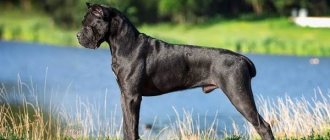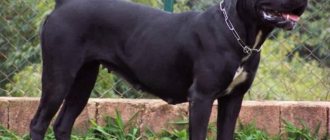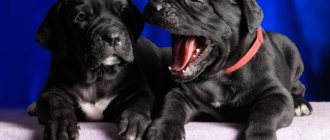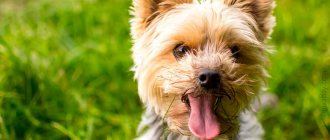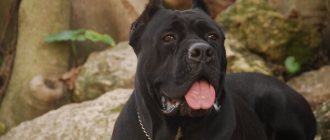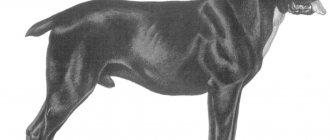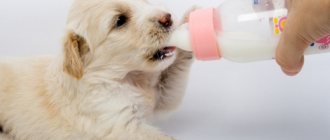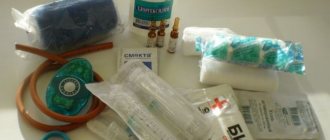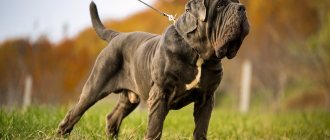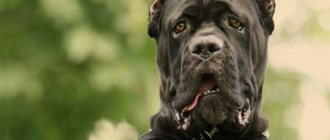Published: 1 year ago ⭐️⭐️⭐️⭐️⭐️
Dry food for Cane Corso is selected taking into account the predisposition to allergic reactions and the increased need for proteins. Due to genetic characteristics, representatives of the breed are prone to gastrointestinal diseases, which manifest themselves with poor nutrition. Compiling a diet yourself is a big risk, so veterinarians advise using ready-made complex feed mixtures.
Let's figure out what to feed the Cane Corso and analyze the best nutrition options.
Rating of the 10 best dry food for Cane Corso
| Place | Name | Rating | Price, rub. |
| 1 | Belcando Junior Maxi for large and giant breed puppies from 3 to 18 months (15 kg) | 10 / 10 | 5 214 |
| 2 | Acana Puppy Large Breed, 11.4 kg | 10 / 10 | 5 050 |
| 3 | Royal Canin Maxi Adult, 15 kg | 9 / 10 | 4785 |
| 4 | Almo Nature Holistic beef 12 kg | 9 / 10 | 4279 |
| 5 | Purina Pro Plan Optiderma for healthy skin and coat, salmon with rice, 14 kg | 8 / 10 | 4113 |
| 6 | Brit Care lamb with rice 12 kg | 9 / 10 | 3999 |
| 7 | OUR DIET WITH BEEF, 15 kg | 7 / 10 | 1670 |
| 8 | Pedigree for healthy skin and coat, beef, 13 kg | 7 / 10 | 1399 |
| 9 | CHAPPI MEAT ABUNDANCE WITH VEGETABLES AND HERBS, adults, 15kg | 7 / 10 | 1381 |
| 10 | ALL DOGS (13 kg) Dry complete | 6 / 10 | 1153 |
Dry dog food is a complete nutritious diet for a pet, developed taking into account the physiology and characteristics of the animal. It contains carbohydrates, fats, proteins, and amino acids in a balanced state. When choosing, pay attention to the composition. The product must contain fats of animal and plant origin and natural ingredients. This is what dogs should receive to be healthy and cheerful.
Feeding
Compound
The Cane Corso's diet does not contain potential allergens (chicken, toxic dyes, aromatic additives).
Take the Attention Test! Find 10 differences! (click right here!)
Find the answer Are you bothered by some problem or question? Enter “Breed” or “Name of the problem” into the form, press Enter and you will find out everything about the issue that interests you.
The following products are used to create complete mixtures:
- Lamb fillet, rabbit, veal, poultry;
- Fish;
- Cereals - barley, wheat, rice, corn;
- Beans and soybeans;
- Vegetable fiber;
- Animal fats;
- Complexes of plant extracts;
- Antioxidants, minerals and vitamins.
Economy and premium food categories contain preservatives, and the protein for them is obtained by processing offal. In the super premium and holistic series, only organic meat and fish are used, and preservatives are replaced with antioxidants.
Choice
For your pet, you need to select a mixture according to the following criteria:
- Age;
- Presence of diseases (dietary diet taking into account the diagnosis);
- Physiological characteristics (pregnancy, molting, feeding);
- Average level of activity.
Incorrectly selected food leads to weight loss, muscle mass and health problems.
Origin story
The ancestors of the breed are Molossian dogs. In ancient times, Cane Corsos served as guards, took part in battles and military operations, and tended herds. As time passed, firearms began to be used in battles, and the need for military dogs disappeared. Already at the beginning of World War II, the number of animals decreased significantly.
Today Italians call the Cane Corso their pride. However, despite its cultural and historical significance, the breed was on the verge of extinction even in Italy. It was preserved by a group of enthusiasts who went in the 70s of the last century to look for preserved individuals to where the breed originated - to Locatia, Puria, Sicily.
They managed to preserve the ancient beauty. The breed was officially recognized by the Italian Canine Association in 1994, and in 1996 by the international organization FCI. In 1999, the Association of Italian Cane Corsos was founded. The standard was adjusted and came into force in 2003. It is still used today by the International Cane Corso Federation.
Belcando Junior Maxi for large and giant breed puppies from 3 to 18 months (15 kg)
Many experts recommend Belcando Junior, made in Germany, for large dogs. Its composition is rich in a high content of poultry meat, in addition to easily digestible rice, which helps good digestion and absorption of useful components. The recipe contains carob fruits, which contain tannins and substances important for life that have an effect on proper digestion. Belongs to the super premium class.
pros
- A complete, balanced complex of nutrients.
- Healthy pet.
- Convenient, economical packaging.
- A wide range of.
- Availability.
- German quality.
Minuses
- Causes an allergic reaction.
- Not all dogs like it.
- Not sold in all Russian cities.
- Composition with sodium chloride.
- Large granules of strange color.
- Poor combination with vitamins and other products.
- There is a minimum of meat, but a maximum of cereals.
First 4 years
The weight of an adult dog already reaches 45 kg for females and 55 kg for males.
As a rule, the first mating is carried out during this period. After it, the males again try to take leadership positions, but this time not within the family circle, but among other dogs. Thanks to their strength, Cane Corsos can cause great harm to other pets with whom they previously played during a walk. Under no circumstances should a dog be allowed to assert itself in this way.
The dog’s character can be adjusted up to three years of age, but the older he gets, the more difficult it is to do this.
Acana Puppy Large Breed, 11.4 kg
Acana Puppy appeals to every furry friend and turns into a favorite bowl. Transforms the animal's fur into smooth and silky, bones will be stronger, and more energy will appear. Thanks to these crackers, your beloved friend is provided with a balanced diet. Many breeders of our smaller four-legged brothers recommend them to everyone else. This is a holistic class.
pros
- Natural.
- Without smell.
- Large packaging.
Minuses
- High price.
- There is a fishy smell.
Features of feeding during pregnancy and after childbirth
During pregnancy and lactation, the dog uses more energy. After the 40th day of pregnancy, each serving of food and liquid should be increased by 25-50%. During this period, it is recommended to provide the dog with constant access to food, as long as it is not prone to obesity. Giving birth and feeding puppies contributes to the expenditure of calories. Fasting at this moment is much more dangerous.
During pregnancy and after childbirth, the female must eat intensively
Royal Canin Maxi Adult dry for large breed dogs, 15 kg
The animal receives a complete diet thanks to Royal Canin. It is designed for individuals weighing from 26 to 44 kilograms, aged from 15 months to 5 years. Its dry granules contain a unique complex of nutrients that helps the digestive system function optimally. They contain a lot of protein, creating a balance with dietary fiber. Royal has natural taste properties with an aroma that evokes excellent appetite in our smaller four-legged brothers. Category: premium.
pros
- Balanced composition.
- High quality.
- Promotes good digestion.
- Maintaining optimal shape and weight.
- Healthy coat, skin, teeth.
- Convenient, practical packaging.
- The pet likes it.
- Gives activity.
- The crackers smell nice.
Minuses
- The packaging is made of paper and does not close after opening.
- Unattractive looking bag of granules.
- Possible only from 15 months to 5 years.
Treatment of infectious diarrhea
For bacterial, infectious diarrhea, veterinarians prescribe Levomycetin, Enterofuril (1 ml for every 2.5 kg), Nifuroxazide, Furazolidone. The dosage, frequency of administration, and duration of treatment are selected by the veterinarian in each specific case.
In addition to treating diarrhea, therapy is aimed at relieving general symptoms and normalizing the condition of the sick animal. Four-fingered patients are prescribed anti-inflammatory, restorative, antibacterial agents, and broad-spectrum antibiotics. To eliminate vomiting - Cerucal, Reglan, other antiemetic drugs. If a dog suffers from debilitating vomiting, the animal is completely limited in food and water. All necessary medications and medications for dehydration are administered intravenously (droppers).
Important! During treatment, owners must strictly follow all recommendations of the treating veterinarian.
The duration of treatment can take from four to seven or more days. Do not skip taking medications, do not exceed the dosage indicated in the instructions for the medication. Medicines in tablets are best crushed into powder, mixed with water and poured into the pet’s mouth using an introducer syringe or a regular one without a needle. You can also add them to food or give them with your favorite treat.
If the puppy is diarrhea due to helminthic infestation, in addition to the main treatment, complex anthelmintics (IN-AP, prazicide, drontal, milbemax) will be prescribed. For puppies, it is best to purchase an anthelmintic in suspension or in the form of sugar cubes. Such medicines have a pleasant taste, so the treatment will proceed without problems.
Almo Nature Holistic beef 12 kg (for large breeds)
Italian crackers of excellent quality with meat additives do not violate European standards. They have the aroma of real meat, causing an excellent appetite in your beloved pet. They contain protein, but in minimal quantities. The animal receives adequate nutrition by consuming it regularly. Almo Nature belongs to the super premium category.
pros
- Dogs love its taste.
- Hypoallergenic.
- Wide range of tastes.
- Fresh natural ingredients.
- There are no artificial additives, dyes, preservatives, or flavors.
Minuses
- Sometimes causes hair loss.
- The pet may refuse to eat it.
Purina Pro Plan Optiderma for Healthy Skin and Coat, Salmon with Rice, 14 kg (Large Breeds)
A healthy body and the well-being of an animal are the result of its optimal nutrition. Purina Pro Plan was developed by Russian veterinarians and nutritionists. The composition includes specially selected nutritional components for four-legged pets of different sizes, weights and ages. It suits even special preferences and keeps the animal in excellent condition. Belongs to the premium class.
pros
- Decent composition.
- Wide range for any age, size.
- Nutritious with all the vitamin complex.
Minuses
- Flavoring additive.
- Doesn't cause much appetite.
- Not available everywhere.
- Creates increased gas formation.
Brit Care lamb with rice 12 kg (for large breeds)
The food is produced in the Czech Republic. It is rich in protein due to the significant amount of natural meat and fish in the recipe. Rice is used, enriching the body with carbohydrates, including fish and chicken oil, which produce fatty acids. Brit Care is most useful for large breeds, because its components prevent joint diseases - a problem for many large four-legged pets. Premium and super - premium class.
pros
- Vitamins and minerals in balance.
- Hypoallergenic.
- Nice smell.
- Causes a huge appetite.
- Optimal size granules.
- High quality.
- For a healthy pet's body.
Minuses
- It smells strong.
- Unpleasant color.
- Too dry.
- Not suitable for all breeds.
- Insufficient bag volume - up to 12 kilograms.
OUR DIET WITH BEEF, 15 kg
OUR DIET, produced in Russia, provides the body of four-legged pets with the entire complex of nutrients, vitamins, and minerals that are so necessary for health. The composition contains natural ingredients, probiotics that support the immune system. The dog is healthy and active all day long thanks to fatty acids, chicken and salmon fat. The listed components are present in the specified diet. Considered economy class.
pros
- Qualitative.
- The dog eats with pleasure.
- Gives activity to the animal.
- The fur shines and shines.
- Well absorbed.
- Choice of flavors.
Minuses
- Large granules.
- Cats eat.
- Only for large representatives of the breed.
Pedigree for healthy skin and coat, beef, 13 kg (for large breeds)
PEDIGREE helps reduce the risk of tartar and plaque formation on your pet’s teeth. Provides him with normal digestion. It is preferable to feed your pet dry food in a container separate from wet food, and ensure the availability of fresh drinking water. This is quite healthy, tasty dog food. It is produced taking into account the physiological needs of a large four-legged pet. The food is produced by a Russian company and is designed for the economy category.
pros
- Convenient packaging.
- Pleasant aromatic and taste properties.
- The pet eats with pleasure.
- No artificial flavors.
- High quality crackers.
- Comfortable in using.
- Lots of vitamins.
- The coat takes on a healthy, beautiful appearance.
Minuses
- Negative reputation.
- Missing useful components.
- Worse than normal nutrition.
- Doesn't do any good.
- Harmful to the health of the animal.
- The pet quickly gets used to this food and does not eat anything else.
- Increases salivation.
CHAPPI MEAT ABUNDANCE WITH VEGETABLES AND HERBS, adults
https://dog-care.ru/zdorove/pitanie/luchshih-suhih-kormov-dlya-kane-korso.html
CHAPPI is produced in Russia for economy class. It contains cereals, which are considered the best sources of carbohydrates. Proteins are present in the form of meat and offal. Use vegetables, for example, carrots, vegetable oils. CHAPPI is convenient because there is no need to add vitamins to it; they are already contained in sufficient quantities.
pros
- Wide availability.
- Nutritious food.
- Does not cause constipation in the animal.
- Decent quality.
- Promotes healthy appearance of coat and teeth.
- Doggies like it.
- There are no artificial flavors or flavor enhancers.
Minuses
- Treatment of the animal after eating these dry granules.
- Bad composition.
- Allergic reactions.
- Hair falls out.
- Bloating.
- Not suitable for all individuals.
- Unattractive packaging.
What should you add to your diet?
For dogs prone to allergic reactions, fish oil and various vitamin and mineral complexes are recommended.
You should give your dog salmon oil daily, as it contains the Omega acids he needs..
If the owner regularly feeds the dog, during the shedding period the dog will not actively lose hair; moreover, its coat will become shiny and healthy.
ALL DOGS (13 kg) Dry complete
ALL DOGS, according to many dog breeders, is considered a complete diet for our smaller four-legged brothers of any breed, size, age and activity level. Each owner adjusts its portions according to the needs of their pet. Together with it, the pet receives a complex of essential nutrients for life. The food is produced in Denmark, based on the latest research on pet nutrition and international standards, which indicate recommended levels of nutritional content. It belongs to the economy class.
pros
- Suitable for almost all breeds.
- Quite popular due to its excellent composition.
- Induces pleasure while eating.
- Excellent oral hygiene and plaque removal.
- Does not contain GMOs, excess or artificial additives.
Minuses
- Not suitable for everyone.
- Insufficient amount of protein.
- You need to add vitamins and natural meat.
- Poor assortment from the manufacturer.
Most of the listed types of dry food, we recommend paying attention to Belcando Junior Maxi and Royal Canin Maxi Adult in the ranking of the best.
This food is based on natural ingredients. Proper nutrition is the key to a healthy body and excellent physical condition of any animal.
The price of these feeds is high, but it is worth it. Moreover, they contain all the useful components, including vitamins, and your beloved pet receives adequate nutrition.
Pros and cons of natural nutrition
The benefits of natural nutrition:
- the owner knows exactly what he feeds the dog and chooses the quality of the food himself;
- lack of preservatives and artificial colors;
- if you have allergies, you can replace products;
- The dog's diet contains protein, carbohydrates, fats and fiber.
Minuses:
- it is necessary to spend time preparing food;
- you need to choose the right diet so that the animal receives all the necessary vitamins and microelements;
- it is necessary to introduce vitamin supplements into the diet;
- It is difficult to take a natural dog on a trip, since you will have to look for a hotel where you could prepare food for it.
However, if the owner decides to feed the dog natural food, he should know what products can be used for this:
- boiled or raw meat;
- fish;
- boiled vegetables;
- porridge;
- eggs;
- dairy and fermented milk products.
It is recommended to give the Cane Corso fish oil, salmon oil, and vitamin and mineral complexes as supplements.
Feeding recommendations for large breed dogs
Large dogs have no less appetite. Individuals with large dimensions have a slower metabolism, they need fewer calories and fat, and they require a higher protein content to maintain shape.
Dry food for large pets varies in granule sizes. For large animals, they are produced about one and a half centimeters in diameter. A smaller granule size will not provide the jaws with full function, which is important for the dog’s health.
Adult pets are fed twice a day, after morning and evening walks. Breakfast and dinner take no more than a quarter of an hour. The bowl is removed even if the food is not eaten. The animal should always have access to clean, fresh water.
The daily amount of food for animals is not the same for equal sizes. It depends on the load experienced by the pet since the last meal. If your pet actively trains or spends a lot of time walking outside, the serving size is increased by a third. If the load is reduced, the pet does not walk much, rests or sleeps more time, the portion is reduced by about 15 percent.
The main indicator of a proper diet is a healthy, well-fed, strong dog whose weight is within the normal range for its age.
Large active animals, service animals, workers, need high-quality nutrition. Suitable feeds marked “energy” or “active”, varieties of “super-premium” or “premium” classes. They contain enough calories, are nutritious, and help improve the digestive system. This diet includes vitamins, dietary supplements, proteins, and amino acids.
It is impossible to give the animal food before training, an active walk or immediately after. Large dogs are at much higher risk of developing volvulus or intestinal blockage than their smaller dogs. These situations are dangerous and require urgent veterinary intervention. After a significant load, you can give the animal to eat after about one hour.
Clinical picture of diarrhea
Diarrhea (diarrhea) is a condition characterized by frequent bowel movements. The excrement has a mushy, thin, watery consistency. Diarrhea in dogs can be acute or chronic, which occurs periodically if the negative factors that caused the diarrhea continue. But as a rule, constant diarrhea indicates profound changes and disturbances in the body.
Important! Chronic diarrhea is most often observed in German shepherds, Great Danes, and Bordeaux dogs. Yorkies, South Russian Shepherds, Pinschers.
As already noted, indigestion is not an independent separate disease, but a symptom of some pathology, illness, or malfunction in the body. Therefore, in addition to diarrhea, owners should be wary of the following symptoms:
- pallor, yellowness, cyanosis (cyanosis) of mucous membranes;
- lethargy, apathy, depression, drowsiness;
- lack of response to external stimuli;
- refusal of food and favorite treats;
- dirty fur near the anus;
- increase in tummy volume;
- mucous, mucopurulent discharge from the nose, eyes;
- sudden increase/decrease in temperature;
- chills, fever;
- cough, difficulty shallow rapid breathing;
- change in heart rate;
- painful defecation, urination;
- refusal of water or vice versa, increased thirst.
The clinical picture, severity, and intensity of symptoms, if they are caused by an infection or disease, depend on the stage, form of the disease, individual characteristics, resistance, and immune potential.
If you notice that the puppy is not eating anything, has become lethargic, apathetic, and other side symptoms are noticeable, do not delay your visit to the veterinarian.
The faster qualified assistance is provided, the greater the chances of saving your beloved pet. Most infectious and bacterial diseases have an aggressive course and occur in an acute, subacute form. Some diseases can be cured at the initial stage of their development. At the same time, uncontrolled use of drugs or self-medication will not produce results and can cause serious consequences.
What vitamins are needed when feeding large breed dogs?
Vitamin complexes are an essential element of the diet of dogs fed boiled meat, offal and vegetables. But when feeding dry food, you may need to take additional vitamins. So that the supplement contains:
- Vitamin C is needed for the functioning of the immune system and ensures the full development of the muscular system, bones, joints, and teeth.
- Vitamin D - used for the formation of the skeleton, especially needed by puppies during the first year of their life.
- Calcium is absorbed along with vitamin D, used to form teeth, skeletal bones, and makes the coat beautiful and shiny.
For large dogs, vitamin complexes are suitable - Beaphar Top 10 Chondro Treat, Unitabs Immuno Complex and others.
How to Feed a Large Breed Dog Puppy as opposed to an Adult Dog
A young animal cannot be fed in the same way as an adult pet. If the size of the puppy exceeds the height of a medium-sized dog, its bones, teeth, and gastrointestinal tract are in the development stage.
This imposes restrictions on the diet:
- Overfeeding and underfeeding a puppy will be equally harmful. But feeds usually contain tables that can be used to calculate the required volume of feed depending on the weight and age of the pet.
- The number of feedings depends on age. At 2 months, puppies are fed up to seven times a day, distributing food evenly throughout the day. By the age of one year, the number of feedings is gradually reduced, bringing it to 2 or 3 times a day. Sudden changes in the amount of food should not be allowed.
- Regardless of whether the pet eats dry food or natural products, it must have access to clean water or milk around the clock. This is especially important for puppies; when eating dry food, there is a high risk of dehydration.
When purchasing a puppy, it is important to discuss with the breeder what the animal ate before the move. It is impossible to abruptly change the diet from natural food to dry food or vice versa. This leads to problems with the stomach, which is sensitive in the young individual.
In case of food intolerance, puppies experience diarrhea or constipation, and allergic reactions are possible. Small dogs are prone to them; large breed puppies do not yet have strong enough immunity. The transition from one type of food to another or changing the brand of food is carried out smoothly and accurately.
General recommendations
Before planning your Cane Corso's diet, you need to understand that various types of allergic reactions are very common among this breed..
You can determine the allergen in a particular case using the exclusion method and remove this product from the diet; When feeding dry food, it is better to use hypoallergenic food.
Another important issue is the dog’s weight.
Even at a young age, excess fat can have a very negative impact on the condition of the dog’s joints, therefore it is recommended to adhere to the following rules that will help control the dog’s weight at any age:
- You need to feed the Cane Corso strictly following the daily norm; if desired, this norm can be divided into several (2-3) meals, but you cannot feed the dog in excess of the prescribed norm.
- It is imperative to compare the amount of carbohydrate food with the dog’s physical activity. If the load is low, the calorie content of the diet should also be reduced.
- If a dog eats artificial food, it may often ask for more. This is due to the fact that dry food increases in volume only after it enters the stomach. Therefore, immediately after eating, the dog may not feel full. If the owner cannot steadfastly withstand the gaze of pleading eyes, he can give the dog a bone from the tendons, but not an additional portion of food.
- The dog must be weighed regularly.
How to feed pregnant large breed dogs
A lack of nutrients in a pregnant bitch's diet will harm her and her puppies, as will an excess of them. Before mating, the dog is given high-quality dry food for adult animals. Once pregnancy is established, there is no sudden change in diet. Portions remain the same while the dog is in the early stages of pregnancy. Excessive nutrition at this stage leads to obesity, which increases the risk of complications during childbirth and endangers the lives of the dog and puppies.
In the third week, the animal may refuse food for up to a week. Active development of the offspring begins in the fifth or sixth week, at which time the daily portion is increased. The serving size is increased by about one third.
As for the brand and class of food, there are groups of food for lactating and pregnant females. Some breeders replace them with puppy food. They contain many useful substances that the expectant mother needs: calcium, phosphorus, vitamins A, E, C and D. It is acceptable to use food of the “holistic” and “super-premium” classes.
Supplements for pregnant bitches improve the well-being of the female and ensure the health of the offspring. Products such as “Quantum ICD Dog-Mama” relieve toxicosis, “Farmina Vit-Active for pregnant and lactating dogs” compensates for the lack of vitamins and minerals, “Unitabs MamaCare” is easily absorbed by animals thanks to its natural flavoring.
Natural or artificial food?
When asking the question of what is better - natural food or artificial food, a reasonable person is unlikely to take one position.
After all, it is clear that both natural and industrial food are quite suitable for keeping a dog, the only question is the quality of the food and the correct feeding of the dog.
It is believed that the Cane Corso is one of the most expensive dogs keep .
The fact is that this breed is quite prone to allergies, as a result of which the owner has to buy expensive hypoallergenic food for his pet for life.
As for the natural diet, it requires constant adjustment depending on the dog’s health and the season..
When feeding a dog, we must not forget that even the highest quality natural products cannot provide it with the required amount of minerals and vitamins.
Expert opinion
Kozhevin Semyon Kirillovich
Expert dog handler.
Most veterinarians recommend feeding your Cane Corso both natural and commercial foods. Of course, industrial food makes the owner’s life much easier, since it is balanced and all the calories in it are counted. It is important to remember the following rule - you cannot mix natural and industrial food, since this can significantly harm the dog’s digestion. If the pet is on artificial food, treats for it should also be selected from industrial ones, but if the dog is fed “natural”, natural favorite foods or pieces of dried meat should be used as treats. You should definitely choose commercial food in strict accordance with the age of the dog. Food for active young dogs contains more vitamins than food for older dogs, and an excess of vitamins and calcium can negatively affect the dog's health.
FEEDING THE PUPPY
When preparing for the arrival of your puppy, think in advance about what kind of dishes your puppy will eat from. The dishes from which the dog eats must be unbreakable. Aluminum or enameled bowls are suitable for this. The inner surface of the bowl must be perfectly smooth and not chipped, otherwise the dog will damage its tongue when it starts to lick it clean. The most convenient cookware is made of stainless steel. Plastic bowls are much less durable and very short-lived. It is better that from childhood, while eating, the dog reaches up to a bowl placed on a stand (you can make it yourself, but, in principle, now such stands on brackets are sold in many “dog stores, and buying them is not a problem), which is fixed on a tripod, depending on the height of the animal, at the level of the elbows or slightly higher. Thanks to this, your pet will develop correct posture. Be sure to ask the breeders what food the puppy is accustomed to at the time of sale. Weaning from its mother, the disappearance of siblings, an unfamiliar environment - all this creates serious stress for the puppy, so he may have a poor appetite during the first days in your home. Don't worry! To make the change in living conditions painless, try to maintain his usual diet. In the future, you can gradually accustom your dog to the feeding regimen that you consider most optimal.
In general, feeding schemes can be divided into three groups:
Traditional feeding
The dog is fed only natural products: stews based on meat, cereals and vegetables, cottage cheese, raw meat, fish. If the diet is chosen correctly, the dog will be in great shape, and the quality of its nutrition can only be envied. But this scheme at the same time has serious disadvantages: it is a rather labor-intensive option for the owner, requires a lot of time, and is not always the cheapest. If the diet is chosen incorrectly, then as a result of an imbalance, various diseases can occur: vitamin deficiency and hypervitaminosis, rickets, etc. Unfortunately, it often happens that owners who feed natural food skimp on meat in every possible way; the dog ends up with practically naked porridge, which, of course, is no good.
Feeding dry food
Now in Russia you can buy food from a variety of companies, but it is still better not to use little-known products; low-quality dry food, naturally, will not bring any benefit to the dog. Well-known manufacturing companies produce a wide range of foods designed for dogs of different age groups and leading different lifestyles. Provided that the food is properly selected, this option is good from all sides: it saves the owner’s time and effort, while at the same time the dog receives a complete, balanced diet, with the correct ratios of proteins, fats, carbohydrates and vitamins.
Balanced food ensures harmonious growth and development of the dog’s skeleton, teeth, muscles, and excellent coat condition. Many companies, in addition to dry food, produce canned food that can be added to food - dogs, as a rule, really like them.
Mixed feeding
Using high-quality dry food plus meat, cottage cheese, kefir. With such a feeding scheme, one rule must be strictly observed. You should not mix dry food with natural food in one bowl - you give the dog only dry food at one feeding, and for example, kefir or cottage cheese at another. Cottage cheese, best homemade (the ratio of milk and kefir is 1:1), meat (preferably pre-frozen lean beef), fish (only sea: cod, hake, ice fish; under no circumstances give your puppy fatty fish and pollock) , brown bread crackers. From cereals - buckwheat and rice. Hercules porridge often leads to intestinal upset, so it can only be given if the dog digests it normally.
What conclusion can be drawn from all of the above? There are adherents of different feeding schemes. You can choose any scheme. If your dog is in good shape - it is not losing weight or gaining weight, it has no signs of allergies, its coat is in good condition and shiny - then your feeding option is suitable for your pet. If not, then there are serious shortcomings in your feeding scheme, and it makes sense for you to review and correct it.
The following ratios should be observed in the diet of an adult dog: meat food - 10-20 g/kg weight, fat - 1-2 g/kg weight, carbohydrates - 5-6 g/kg weight. For puppies these figures are 2-3 times higher. The number of feedings depends primarily on age. A puppy of one to two months should be fed 5-6 times a day, a puppy of three or four months - 4 times, five months and older - 3 times. Adult dogs are usually fed twice a day: morning and evening.
If you decide to feed your puppy dry food, it is very important to choose the right one. So, the food of all reputable companies is divided into various groups according to energy value, content of vitamins and minerals and takes into account the needs of the dog from the moment of birth until the end of its life. There are foods for small puppies, teenage puppies, adult and aging dogs, nursing bitches, dogs with increased and decreased physical activity, long-haired dogs, etc. The required amount of food per dog's weight is indicated on the packaging. All this is quite individual, because dogs, like people, have different metabolisms. One dog may eat very little and be fat, while another may have to be given double the amount of food to be in normal shape.
Good condition of a dog is determined as follows: the dog's ribs should be palpable when lightly pressed. If the dog’s ribs are easily palpable, the groins are tucked in, the waist is clearly visible, the ridge is visible - this means that the dog is exhausted, which is completely unacceptable.
A very fat dog is also bad. Firstly, it’s simply not aesthetically pleasing; with such a dog you can’t count on good results at shows. Even a beautiful thoroughbred head in the presence of such a huge body seems disproportionately small. Your back may sag and your legs may move. But the saddest thing is that an obese dog cannot be healthy. She may develop many diseases, including coronary heart disease.
Some dogs have an allergic reaction to certain foods. If you are starting to give your dog new food, you should not immediately buy large bags. Feed a small bag first, if there is no allergy, the dog is in good shape, only then can you switch to this food. Good companies have special lines of food intended for dogs with allergies (lamb with rice).
Whatever feeding plan you follow, remember that:
Do not feed dogs hot, cold, spicy, salty, fatty, sweet or smoked food. The dog should not know what sausages, sausage, or ham are. We know many owners who are capable of doing the incredible for their pet and will not stand up to any expenses or difficulties. In this case, all this is completely in vain. Sausages are poison for dogs. They damage the liver, and the dog runs the risk of dying at a young age. After all, we don’t know what additives are added to sausages to make them look attractive.
The following should be excluded from your dog's diet:
• Broth, even the most dietary one;
• Pork – pork meat is too fatty, which puts a lot of stress on the liver;
• Lamb – also too fatty for dogs;
• Raw river fish – in most cases, river fish is affected by helminth larvae (worms). The fish must be boiled and all the numerous bones removed;
•Bones - contrary to the deep-rooted misconception, bones are death for a dog. Firstly, they are not digestible. Secondly, they can cause constipation, intestinal perforation, and volvulus. Particularly dangerous are tubular bones, which tend to split into sharp pieces. Bones also help teeth wear down quickly;
• Pasta - has no nutritional value, stretches the stomach and causes fullness.
• Any alcohol can lead to coma and even death;
• Salt - in large quantities, it disrupts the water and electrolyte balance of the body, which can lead to muscle cramps and spasms, or even congestive heart failure;
• Peas, beans and other legumes are not food for a dog, it is not a pig, dogs do not have good enough removal of gases from the intestines.
• Mushrooms - may contain toxins that cause damage to the liver and kidneys;
• Chocolate – contains theobromine, a heart stimulant and diuretic. This can be fatal for the dog;
•Sugar and sweets - sweets spoil the appetite and disrupt digestion. In addition, they destroy teeth and have an extremely adverse effect on the eyes, which begin to water;
•Yeast dough is the cause of gas and bloating, leading to rupture of the digestive system and hernia;
• Grapes and raisins – grapes contain an unknown substance that destroys the dog’s kidneys; citrus oil extracts - may cause vomiting;
• Broccoli - toxic in large quantities;
• Most fruit pits and seeds - contain cyanogenic glycoside, which leads to cyanide poisoning. Although the fruit itself is not harmful;
• Spices - pepper, bay leaf, spicy tomato sauce and nutmeg. Nutmeg can cause convulsions and seizures and damage the central nervous system;
• Onions and garlic - contain a toxic component - thiosulfate. Onions are more dangerous because... contains more of this toxin;
• Coffee and tea are dangerous due to caffeine;
• Human vitamins - especially those containing iron, cause damage to the liver and kidneys;
• Potato peels and green potatoes - contain oxalate, which can affect the digestive, nervous, and urinary systems;
• Poor-quality, spoiled dry food – dry food is a very good breeding ground for microorganisms, which successfully multiply in it if storage conditions are violated;
• Poor quality products – often leads not only to gastrointestinal disorders, but also causes food poisoning;
• Moldy, rotten, sour, spoiled food - no comments necessary.
